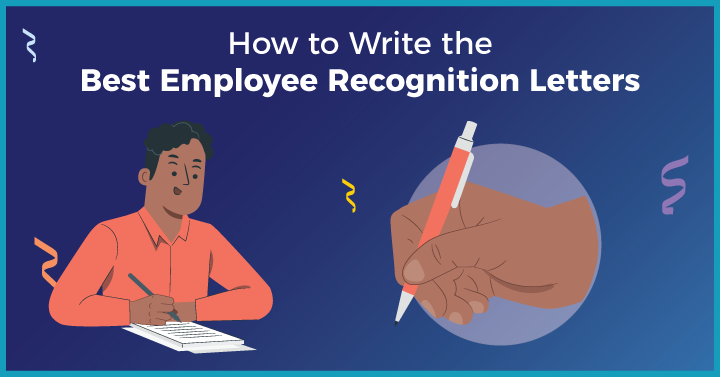Finding the right staff can be a challenge, which is why it pays to make every effort to appreciate and retain the high-performing individuals you’ve already hired. Employee recognition letters are a great way to show your appreciation for a job well done and reinforce positive attitudes.
How do you write a good recognition letter? Make sure you get the format right with this concise guide.
1. What Is an Employee Recognition Letter?
Employee recognition letters are written communications that acknowledge a member of staff’s contribution. They can be formal or informal in tone, though they almost always focus on specific achievements or milestones. While they are usually sent from a manager to a subordinate, some companies have begun initiating programs where peers can congratulate one another on a particular project or for general hard work.
2. Why Is Employee Recognition Important?
Employee engagement and motivation are two of the main reasons why letter recognition is important. This in turn can have beneficial effects on performance and decrease turnover, as well as creating a favorable team dynamic. Research from employee engagement experts Reward Gateway found that 90% of HR workers believe effective recognition and rewards drive business results.
3. Elements to Include in an Employee Recognition Letter

1. Make It Personal While Keeping It Professional
Take the time to write individual messages in your employee recognition letters. While copying and pasting might save time, the lack of personal touches will make the praise sound hollow. At the same time, you should maintain a professional tone throughout.
2. Use Employee Name
Address the employee directly by name. Just like in conversation, using someone’s name in an email makes them feel important and establishes a rapport, as the self-improvement author Dale Carnegie famously noted.
3. Keep It Short
Take the necessary time to describe someone’s contribution with specificity and precision, but don’t get bogged down in flowery prose. Clarity and concision are the watchwords of successful employee recognition letters.
4. Mention Recent Milestones
Single out a person for praise soon after the completion of a project or they succeed in an objective. Employee recognition letters work best when directed at recent actions, so the individual receives rapid affirmation and reinforcement of their positive behaviors.
5. Stick to a Positive Tone
Semantics are important. To create a positive tone, state what someone did rather than what they did not do, i.e., “You communicated clearly,” instead of, “You did not fail to make yourself understood.”
6. Express Appreciation
What is a recognition letter for if not to express appreciation? Don’t forget to explicitly convey your gratitude for an individual’s hard work as well as elucidate their achievements.
4. 10 Different Occasions for Recognition
1. New Joiner
Take the time to acknowledge a new member of the team during the early days of their employment. This will get your working relationship off to a good start and instill your company’s culture of recognition from the very beginning.
2. Long-Term Association
Just as it’s important to welcome new hires, it’s also important to salute departing staff, especially if they’ve worked with the company a long time. This should be done not just out of appreciation or politeness, but also because it will encourage them to remain an advocate for your business and possibly lead to future collaborations.
3. Going the Extra Mile
Another reason to send employee recognition letters is when someone gets involved in organizing company events or is an active participant in corporate initiatives. These people may not expect a reward, but applauding their attitude sends a positive message.
4. Leadership Role
Leadership skills are among the most desirable attributes an employee can have. Expressing approval helps to solidify these behaviors, as well as tangentially inspiring others to take the initiative.
5. Work Anniversaries
Managers can show they are invested in a person’s career at a company by celebrating work anniversaries with a congratulatory email. Remember to be specific about the individual’s contributions so far and highlight what they bring to the team.
6. Training & Helping Others
Employee recognition letters are a useful way to commend staff who take the time to assist their colleagues with tasks or teach them how to use certain software. Anyone fostering a productive working environment deserves appreciation.
7. Punctuality
Punctuality is often overlooked as an attribute unless it becomes a problem, but it can have a significant impact on team morale. Additionally, being on time gives the impression of professionalism to people inside and outside the company, which is why it should be encouraged.
8. Promotions
Sending a recognition letter when an employee is promoted isn’t just about conveying good wishes. It can also be used to communicate confidence in someone's ability to take on a new role, bolstering their self-belief and letting them know you are there to offer support.
9. Annual or Year-End Recognition
Summing up a person’s greatest achievements over the past 12 months is a nice way to conclude the year. It’s also worth noting that January is the month when most employees quit their job, having used the holidays to reflect on their role. As such, it’s pragmatic to send a personal thank you for your staff’s hard work before sending them off for the Christmas/New Year break.
10. Delivering on Projects
The quintessential reason to send employee recognition letters is when a person or team has worked particularly assiduously on a project, presentation or objective. Highlighting this fact shows an employee that their hard graft is noticed and buoys them to emulate their success in the future.
5 Sample Letters of Employee Recognition

5.1 Recognition Letter for New Hire
Dear Tim,
I wanted to personally thank you for the hard work you’ve put in so far. Though you’ve only been with the team for three weeks, it’s clear to everyone that you are a very conscientious person with a keen eye for mistakes in the magazine copy.
I’ve also been very impressed with how quickly you’ve learned to use the publication’s custom CMS to make edits to articles and adjust the layout. It takes some getting used to, but you seem to be handling the challenge admirably.
Once more, welcome to the team and I look forward to working with you more.
Best regards,
Roderick Spode
5.2 Recognition Letter for Going the Extra Mile
Dear Anil,
Thank you very much for all your effort in organizing the departmental relay team for the company sports day. It was a huge help to me, and I appreciate that you took time out of your day to ensure everything went smoothly.
It’s a pleasure to work with somebody who is so enthusiastic about building camaraderie, and I know your enthusiasm has a huge impact on the overall positivity of your colleagues.
Keep up the great work!
Many thanks,
Roderick Spode
5.3 Recognition Letter for Work Anniversaries
Dear Wilma,
From everyone at Fictional Company Ltd., congratulations on your 10-year work anniversary!
I know I speak for the whole organization when I say you are an inspiration to everyone here. Your dedication and acumen have been an example to the entire IT team, many of whom have spoken to me about the patient, kind way you have helped them to resolve complex issues over the years.
Recently, your active role in navigating the ongoing cloud migration process has been a real boon to the company generally as well as me personally.
I look forward to working with you on this and many other projects in the years to come.
Warmest regards,
Roderick Spode
5.4 Recognition Letter for Year-End
Dear Nils,
On behalf of Fictional Company Ltd., I want to thank you for all the hard work you’ve put in this year.
It has been a very labor-intensive few months, but your zeal and drive have been an energizing force within the team. As we near the completion of this phase of the rollout, I want you to know that your contribution to implementing the marketing strategy has been greatly appreciated.
In particular, your confident management of our social media channels has been wonderful to observe, driving engagement to our greatest heights yet.
I look forward to seeing even more from you next year!
Best regards,
Roderick Spode
5.5 Recognition Letter for Delivering on Projects
Dear Layla,
Congratulations on achieving your quarterly sales target. Your consistent ability to deliver in spite of difficult economic circumstances has been extremely impressive and remarked upon by members of senior management.
I believe you have the necessary skills to achieve great things at Fictional Company Ltd. If you have some time later this week, I would like to sit down with you to discuss in greater detail your career opportunities going forward.
Your sincerely,
Roderick Spode
6. FAQs
- What to Say to Recognize an Employee?
Praise specific actions or success an employee has had while also highlighting their strengths. For instance, you might express approbation after an employee has landed an important client, noting their tenacity and organization in the process.
- What Is an Example of Employee Recognition?
You can recognize employees for everything from career milestones (such as a promotion), to excellent soft skills (such as punctuality or organization), to quantitative achievements (such as delivering a good ROI with a marketing strategy).
- How Do You Start Off a Recognition Letter for Employees?
Employee recognition letters should be personal but also formal. As such, it’s common to begin with ‘Dear [Insert Employee Name]’. If you are writing an actual letter as opposed to an email, you might want to begin by including a traditional header, including the date, the address of the individual and the address of the company.
 Interested in Virtual Team Building Events?
Interested in Virtual Team Building Events?





















